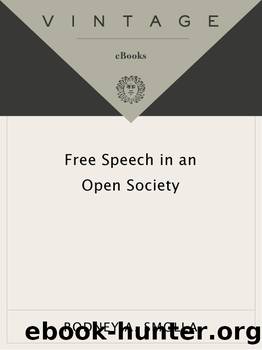Free Speech in an Open Society by Rodney A. Smolla

Author:Rodney A. Smolla [Smolla, Rodney A.]
Language: eng
Format: epub
ISBN: 978-0-307-77303-6
Publisher: Knopf Doubleday Publishing Group
Published: 2011-01-12T00:00:00+00:00
PUBLIC UNIVERSITIES
How should a state university campus be classified? The soundest view is to treat the campus not as one unified forum, but as subdivided into multiple forums, in which differing free speech standards apply. On every state university campus, there are places that should be considered âtraditionalâ public forums. This is the place on the campus that is the functional equivalent in campus life of the Boston Common or the Washington Mall, or the streets and sidewalks in front of the seat of government. The geographies of campuses differâat some universities, this traditional forum may be the open campus green or plaza, at others it may be the entrance to the student union or the main classroom building. But every state campus, like every city, should be understood to have at least one location permanently dedicated to wide-open discourse, a First Amendment âfree-fire zoneâ in which the principles of free speech in the open marketplace apply with undiminished force.
In addition, most state universities should be treated as having turned large parts of the campus into âdesignatedâ public forums. The Supreme Courtâs most significant foray into this issue came in its 1981 decision in Widmar v. Vincent,154 involving the University of Missouri at Kansas City. The universityâs policy was to encourage the activities of student organizations, and it officially recognized over one hundred student groups. The university regularly provided facilities for the meetings of registered organizations, and students paid an activity fee to help defray the costs to the university. From 1973 until 1977, a registered religious group named Cornerstone, an organization of evangelical Christian students from various denominational backgrounds, had regularly sought and received permission to conduct its meetings in university facilities. In 1977, however, the university informed the group that it could no longer meet in the university buildings. The exclusion was based on a regulation adopted in 1972 by the university forbidding the use of university facilities âfor purposes of religious worship or religious teaching.â155 The university defended its regulation on the grounds that the prohibition was necessary to avoid a violation of the Establishment Clause of the First Amendment. The Supreme Court held the Missouri restriction unconstitutional. Because the Court was convinced that permitting a student religious group to use the universityâs facilities on the same terms as other student groups could not be construed as an implicit endorsement of the religious groupâs message, the Establishment Clause would not be violated by letting the religious group in. The university had designated its facilities as open forums, the Court held, and therefore could not discriminate against religious speech. âThe Constitution forbids a State to enforce certain exclusions from a forum generally open to the public,â the Court stated, âeven if it was not required to create the forum in the first place.â156
What does Widmar really mean? Widmar might be understood for the proposition that by virtue of the large quantity and diverse quality of speech that state universities customarily permit on campus, they are in all respects âdesignatedâ open public forums.
Download
This site does not store any files on its server. We only index and link to content provided by other sites. Please contact the content providers to delete copyright contents if any and email us, we'll remove relevant links or contents immediately.
Machine Learning at Scale with H2O by Gregory Keys | David Whiting(4199)
Killers of the Flower Moon by David Grann(3971)
Oathbringer (The Stormlight Archive, Book 3) by Brandon Sanderson(2902)
Will by Will Smith(2795)
Once Upon a Broken Heart by Stephanie Garber(2689)
Guns, Germs and Steel by Diamond Jared(2304)
Borders by unknow(2232)
It Starts With Us (It Ends with Us #2) by Colleen Hoover(2206)
Friends, Lovers, and the Big Terrible Thing by Matthew Perry(2126)
The Room Where It Happened by John Bolton;(2106)
The Color of Law by Richard Rothstein(1888)
HBR's 10 Must Reads 2022 by Harvard Business Review(1782)
The Strength In Our Scars by Bianca Sparacino(1778)
A Short History of War by Jeremy Black(1764)
Water Rights and the Environment in the United States by John Burch(1645)
Examples & Explanations: Administrative Law by William F. Funk & Richard H. Seamon(1605)
515945210 by Unknown(1602)
A Game of Thrones (The Illustrated Edition) by George R. R. Martin(1595)
That Every Man Be Armed by Stephen P. Halbrook(1549)
